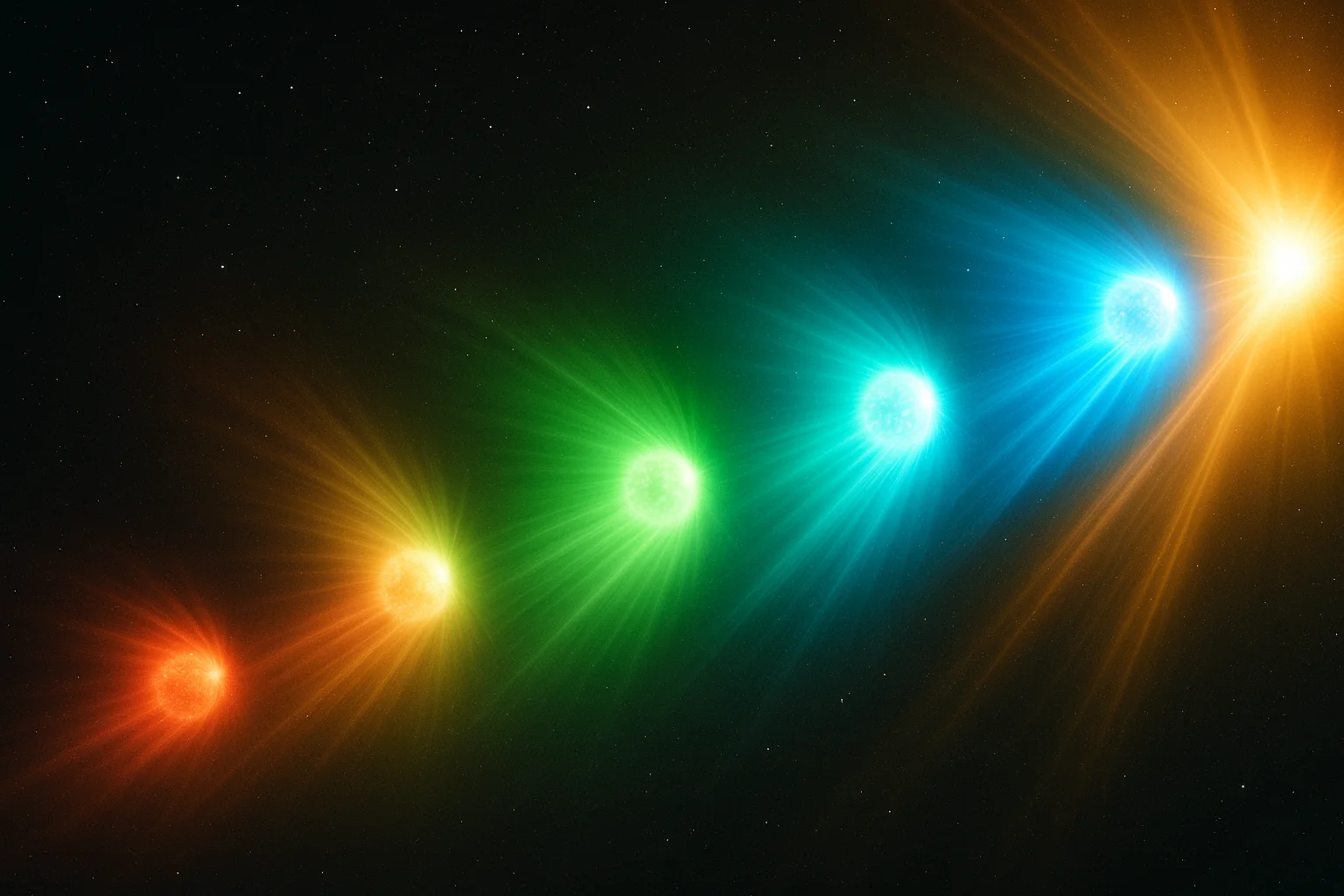The Cosmic Chameleon
Imagine watching a distant star suddenly cycle through colors like a cosmic traffic light: red, then green, then brilliant blue. That's exactly what astronomers witnessed when interstellar visitor 3I/ATLAS began its dramatic approach to our Sun in late 2025.
This mysterious object, originating from another star system entirely, displayed color-changing behavior so unprecedented that it initially sparked speculation about artificial origins. Could this be evidence of alien technology with an energy source hotter than the Sun itself?
The answer, as science often reveals, proved to be far more fascinating than fiction. What appeared to be potentially artificial behavior turned out to showcase the exotic chemistry of interstellar objects encountering our solar system for the very first time.
The Dramatic Color Transformation
The transformation of 3I/ATLAS unfolded like a carefully choreographed light show throughout 2025. Initially appearing with the typical reddish hue of most distant comets, the object began its spectacular metamorphosis as it approached the Sun.
Key Points
- September-October 2025: Rapid brightness increase began as 3I/ATLAS approached perihelion (closest solar approach on October 29)
- Color evolution: Systematic shift from red to green to brilliant blue
- Brightness surge: Increased proportional to distance^-7.5, far exceeding normal comet behavior
- Coma formation: Developed a 300,000 km bright envelope visible to space-based coronagraphs
Space-based observatories including STEREO-A, SOHO, and GOES captured this unprecedented display during the comet's solar conjunction. The timing was perfect: as 3I/ATLAS swung around the Sun, multiple spacecraft could track its dramatic brightening and color evolution in real-time.
The most striking aspect wasn't just the brightness increase, but the systematic color progression that defied conventional comet behavior.
The Scientific Mystery vs. Speculation
The unusual blue coloration immediately caught the attention of researchers, including Harvard astrophysicist Avi Loeb, who posed intriguing questions about the object's nature. Traditional comets typically appear reddish due to organic compounds and dust. A brilliant blue color suggested something entirely different.
The Alien Technology Hypothesis: Initial speculation centered on whether 3I/ATLAS might possess an artificial energy source capable of generating temperatures hotter than the Sun's surface, explaining the intense blue emissions.
Photometry data revealed the object's bluish coloration was the complete opposite of typical comet behavior. Previous observations of 3I/ATLAS had shown conventional reddish tones, making this transformation even more mysterious.
However, the scientific community maintained healthy skepticism. Extraordinary claims require extraordinary evidence, and researchers began investigating whether natural processes could explain this cosmic light show.
The Natural Explanation: Comet Chemistry in Action
Recent scientific analysis has revealed the elegant natural explanation behind 3I/ATLAS's color-changing performance. The answer lies in the unique chemistry of an interstellar object experiencing our Sun's radiation for the first time.
The process unfolds in distinct phases:
• Initial Phase (>2 AU from Sun): CO₂ sublimation keeps the nucleus relatively cool, maintaining typical reddish appearance
• Transition Phase (<2 AU): Rapid water ice sublimation begins, dramatically increasing gas production
• Blue Phase: Release of excited C₂ (carbon) molecules and ammonia creates brilliant blue luminescence
Radio telescope observations confirmed this explanation by detecting hydroxyl emissions—the telltale signature of water molecule breakdown. Gas production rates increased by a factor of 10 between September and October 2025, perfectly correlating with the color transformation.
Why Interstellar Comets Behave Differently
The key to understanding 3I/ATLAS lies in recognizing it as a first-time visitor to our solar system. Unlike solar system comets that have made multiple trips around the Sun, interstellar objects like 3I/ATLAS arrive with pristine compositions and different thermal histories.
When 3I/ATLAS encountered our Sun's intense radiation, it underwent chemical processes that had never occurred in its billions of years of interstellar travel. The dramatic color changes represent the object's first-ever response to solar heating—a cosmic baptism by fire.
The Physics is Predictable: While the visual display appeared mysterious, the underlying physics follows well-understood principles of comet chemistry and solar heating effects.
This explains why the behavior seemed so unusual compared to familiar solar system comets, which have been processed by countless previous solar encounters.
Science Triumphs Over Speculation
The 3I/ATLAS color mystery demonstrates the power of evidence-based scientific investigation. What initially appeared potentially artificial revealed itself as a natural laboratory showcasing exotic comet physics in action.
This case study offers valuable lessons about interstellar visitors and scientific methodology. Rather than jumping to extraordinary conclusions, careful observation and analysis revealed the fascinating natural processes at work.
3I/ATLAS has given us unprecedented insights into how interstellar objects behave when encountering new stellar environments. These lessons will prove invaluable as advanced surveys discover more visitors from other star systems.
Ready to explore more cosmic mysteries? Follow our ongoing coverage of 3I/ATLAS and other interstellar visitors as we continue unraveling the secrets of objects from beyond our solar system. Subscribe to stay updated on the latest discoveries that are reshaping our understanding of the cosmos.
